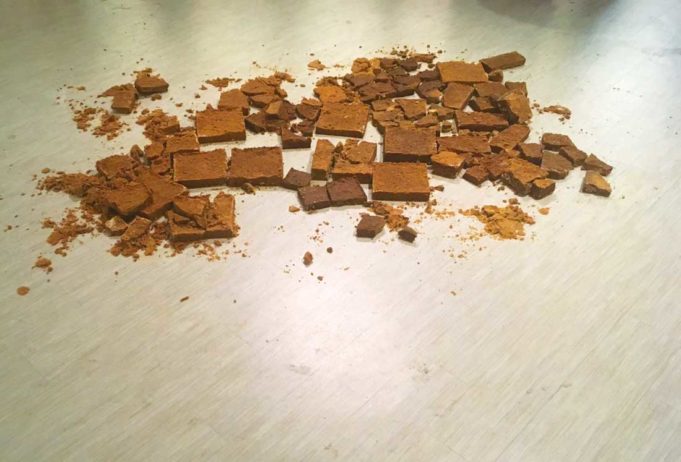There is a distinct whiff of sweetness in the air as you enter Fort Works Art. It is coming from Fabiola Valenzuela’s floor sculpture “Dulce y Suave.” Laid out in a grid, the piece consists of 28 7-inch squares of dark brown sugar that quickly morph, cracking and disintegrating into a formless mass, unprotected in the middle of the floor. The irony of crumbling under its own weight is an apt appraisal of Valenzuela’s sculpture, which is a critique of white skin standards of beauty at the expense of fetishizing women of color or otherwise totally ignoring them as undesirable Others. We celebrate J. Lo and Beyoncé as goddesses, but black women on Tinder can’t catch a date. The work endures and persists despite the trampling and destruction that were its inevitable fate as a floor piece on Spring Gallery Night two weekends ago.
Installed between “Mexican American Me” and “Nude on Red Couch,” two paintings by Jesse Sierra Hernandez, who shares top billing with Valenzuela as part of their shared show, Out of Focus, “Dulce” brings into focus some of the works’ strongest themes — cultural identity and the presence of artists in their works.
Valenzuela’s installations are richly autobiographical, often mining her family history to create sculptures and drawings that are personal and sometimes interactive. For her show at the Texas Biennial in Austin last September titled Cake, Valenzuela presented five cakes decorated with the welcome letters to newly sworn-in citizens from three U.S. presidents. Bill Clinton, George H. W. Bush, and Barack Obama each outlined his view of what it means to be an American, and through the letters Valenzuela posed the question to us.
Her work also reflects on cultural identity by diving into how Western standards of beauty affect women of color. In her text pieces “Esta Prietito Pero Bonito” and “Guerito Guerito Y Bien Bonito,” Valenzuela reveals the colorism tropes common in intra-cultural favoring of light skin. “Dark but cute” and “Light skinned and very cute” describe how these judgments begin from the birth of a child well into adulthood.
Somewhere between Valenzuela and Hernandez, we gain an insight into the world of two artists proposing big ideas about things important to them. The last time they worked together was at the weeklong exhibition in the lobby gallery of the Kimbell Art Museum’s Piano Pavilion. Valenzuela’s installation “Things We Learned from My Mom” and Hernandez’s “Conversion of Saint Paul” hung across from each other. Hernandez has included “Conversion” in their show at Fort Works Art as part of a series of paintings that demonstrate how an artist can be influenced by, and have a strong conversation with, historical works of art.
“Conversion” portrays four soldiers dressed in camouflage and flak jackets standing lookout as a fifth, who bears an uncanny resemblance to Hernandez, protects the fallen Paul (or Saul, as the story goes in the New Testament). Hernandez’s recreation of the Caravaggio masterpiece diverges significantly from the original but embodies the spirit of the work even as he transposes soldiers from this era into scenes from 2,000 years ago. In compositions that play out like the Terminator’s guide to art history, Hernandez’s soldiers protect Saul, carry away Jesus, and bring us along as witnesses. It resembles the messiah narrative in James Cameron’s fable of John Connor who sends a robot back in time to save us from ourselves. In this string of J.C. initials, is Hernandez John Connor come to save us from the impending dystopian rise of the machines?
In “The Taking of Christ (after Caravaggio),” Hernandez taunts viewers with his ability to linger in drapery and the subtlety of shadow details where deep dark areas of canvas should be. Light reflecting off armor and Kevlar helmets of soldiers too bearded to pass morning inspection are just bright enough to reveal the mustachioed Hernandez in the background. He holds up a lantern to the painting, bridging the connection between paintings he sees every day as head preparator at the Kimbell and his own.
The style and subject of Hernandez’s paintings come from his 20-plus years as a painter and reveal a more purposed and engaged artist than either of us was in our 20s, when I was first introduced to his art practice. This evolution from painted nudes and pop icons in the bacchanalian decadence of the defunct Wreck Room, and the frequent exhibitions at his Studio 4 space behind that West 7th Street venue, to the present is complete. Almost. At the legendary Fort Worth venue, Hernandez’s paintings of flesh were at the height of their relevance and complemented those dark grottos and all the debauchery that they invited. But for all their finesse and dramatically executed drapery, when seen in the glaring lights at Fort Works Art, the nudes, now refined, reclining and texting on couches, dissolve into paintings that are meant for another era and do very little to refute criticisms of the male gaze in art. The inclusion of “Nude on Red Couch” and “Two Nudes, One Couch” reads more as a survey of Hernandez’s complete body of work than as a complement to Valenzuela’s, and they work only when contrasting beauty objectified and idealized next to brown sugar squares literally crumbling under the weight of that comparison.
Featuring works by Megan Van Groll and Kate Stipp, My Eyes Are Up Here, the second of three exhibitions at Fort Works Art (the third is Adam Palmer’s Sentimental Circus), can be viewed in conversation with Out of Focus. Van Groll’s nudes are intense studies of female bodies in space, contorted, grimacing, and literally wrestling with what the gallery describes as “cultural forces that shape the lives of women.” In the slip between agony and ecstasy, Van Groll’s “Burn” is a cropped view of a woman’s head and shoulder, her pink flesh pressed against a pink background with her gaze fixed partially on the viewer and presumably another figure. Her expression is ambiguous, and compelling, and that complexity lingers through the rest of the paintings.
The breadth of works in these three shows both pits their themes against one another and reinforces the lines between history, culture, and gender. When they work best, we celebrate those differences, champion those issues, and question those legacies.
Three shows
Thru May 5 at Fort Works Art, 2100 Montgomery St, FW. Free. 817-759-9475.












